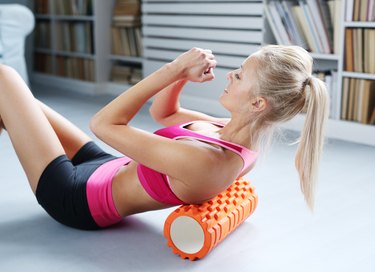
You might associate the foam roller with recovery, but it can also be used during your workouts to strengthen your muscles. Foam rollers are frequently used to loosen up your hips, thighs and calves, but your shoulders also benefit from these cylinders of polyethylene foam that range in size from 1 foot to 4 feet in length and 4 inches to 6 inches in diameter.
Use a foam roller for your shoulder to improve range of motion and alleviate pain and tightness. Several simple exercises take just a few minutes, but will make a world of difference in your function and posture.
Video of the Day
Video of the Day
Warning
If you're using a foam roller to deal with chronic shoulder pain, check with a doctor to clear yourself of any serious conditions.
1. Rotator Cuff Rolling
The rotator cuff is a common site of soreness and tightness. The supraspinatus, teres minor, infraspinatus and the subscapularis are the muscles that make up this complex part of your anatomy. These muscles easily become bound up and are a source of discomfort and compromised range of motion. You may even feel the effects of a tight rotator cuff in other associated muscles, including the upper spine, neck and wrist.
Use a textured foam roller, known as a rumble roller, for the exercise to get deep into this complex area.
- Lie on your side and place the foam roller just under your armpit area at the base of your upper back.
- Rock your torso back about 45 degrees to direct your chest more toward the ceiling.
- Keep the roller steady as you move your trunk right to left on the roller in a side to side motion. Do this 10 to 20 seconds.
- Change your motion to roll up and back just a few inches; the movement is concentrated at the back of the scapula, or shoulder blade. Do this for 10 to 20 seconds.
- Release and shake out your arm and circle your shoulder to relieve the trigger point.
During foam rolling, the sensations may be quite intense. Make sure you can breathe through the massage and aren't tearing up in pain.
2. Anterior Deltoid and Chest Drill
Use a medicine ball or therapy ball as an alternative to a foam roller for your anterior deltoid and chest. The ball provides a little deeper sensation as it conforms to these muscles better, but a foam roller will do.
- Lie facedown on the floor and place the foam roller under the front of the shoulder. The roller should align vertically with your torso.
- Allow your weight to surrender into the roller as you move right and left to massage the entire front of the shoulder and chest; you might even go down the bicep for an extra release. Keep rolling for up to 60 seconds.
Always do both sides to evenly stretch out.
Read more: Foam Roller Exercises for the Neck
3. Foam Roller Push-Ups
Foam rollers can also be a surprising strength tool. Use them as you would any sort of unstable, incline surface to increase the need for your abs to contract and intensify the work of the fronts of your shoulders. For this move, use two short foam rollers or one long one.
- Place the foam rollers parallel to each other in front of you. They should face vertically and be slightly wider than your shoulders. Alternatively, use one long roller and place it perpendicular to your chest.
- From an all-fours position, put one hand on each roller. Press into the rollers, contract your abs and extend your legs behind you into a push-up position. If you're using one roller, place both hands on the roller shoulder-distance apart as you extend into a plank.
- Bend your elbows to lower your chest to the height of the rollers. Extend the elbow joint to return to the top. Avoid allowing the rollers to move around — part of the exercise is controlling the unwieldy nature of the equipment.
Read more: The Do's and Don'ts of Foam Rolling
4. Thread the Needle Stretch
The backs of your shoulders benefit from the thread the needle stretch. This move helps you become more mobile in the posterior deltoids as well as in the thoracic, or upper-middle, spine.
- Get onto an all-fours position and lean your buttocks back to sit toward your heels, just like you would in a child's pose position from yoga. Place a foam roller parallel to your right side. Have it face vertically in line with your trunk.
- Thread your left arm under your torso and right armpit. Rest the left forearm on the foam roller. Turn your left ear to the ground. Reaches your right arm up past your ear, but keep it connected to the floor.
- Hold the stretch for 10 to 20 seconds, or roll your arm back and forth on the roller to get greater sensation.